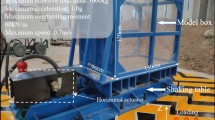Abstract
One of the most important issues in the evaluation of geological hazards is the delineation of landslide prone areas and the estimation of the slope failure potential. In this study, the GIS-based Newmark’s displacement method was applied for the first time in Greece, in order to compute the permanent displacement values and evaluate the slope failure potential in the area of the Skolis mountain in NW Peloponnesus, Greece. The resulting maps were validated using the distribution of secondary effects triggered by the 8 June 2008 earthquake. The study indicated that as the source areas of the rock falls were delineated by the Newmark displacement method, this may be a useful approach to predict earthquake-induced slope failures when the seismic potential of an area has been previously evaluated.
Résumé
Un des thèmes les plus importants dans l’évaluation des aléas géologiques est la délimitation des zones sujettes à glissements de terrain et l’estimation des risques de rupture de terrain. Dans cette étude, la méthode de Newmark, sur une base SIG, a été appliquée pour la première fois en Grèce, afin de calculer des valeurs de déplacement permanent et d’évaluer le risque de rupture de pente dans la région des montagnes de Skolis dans le nord-ouest du Péloponnèse (Grèce). Les cartes produites ont été validées à partir de la répartition des effets secondaires déclenchés par le séisme du 8 juin 2008. L’étude a montré que, la zone source de chutes de blocs étant délimitée par la méthode des déplacements de Newmark, cette approche peut être utile pour prévoir les glissements déclenchés par des séismes lorsque l’activité sismique d’une région a été au préalable évaluée.










Similar content being viewed by others
References
Abrahamson NA, Silva WJ (1997) Empirical response spectral attenuation relations for shallow crustal earthquakes. Seism Res Lett 68:94–109
Ambraseys NN, Menu JM (1988) Earthquake-induced ground displacements. Earthq Eng Struct Dyn 16:985–1006
Ambraseys NN, Simpson KA, Bommer JJ (1996) Prediction of horizontal response spectra in Europe. Int J Earthq Eng Struct Dyn 25:371–400
Boore DM, Joyner WB, Fumal TE (1993) Estimation of response spectra and peak acceleration for Western North America earthquakes: an internal report. Open-File Report 93–509. US Geological Survey, Menlo Park
Ganas A, Seprelloni E, Drakatos G, Kolligri M, Adamis I, Tsimi Ch, Batsi E (2009) The Mw 6.4 SW-Achaia (Western Greece) earthquake of 8 June 2008: seismological, field, GPS observations and stress modelling. J Earthq Eng 13(8):1101–1124
Jibson RW (1993) Predicting earthquake-induced landslide displacements using Newmark’s sliding block analysis. Transp Res Rec 1411:9–17
Jibson RE (2007) Regression models for estimating coseismic landslide displacement. Eng Geol 91:209–218
Jibson RW, Keefer DK (1993) Analysis of the seismic origin of landslides: examples from the New Madrid Seismic Zone. Geol Soc Am Bull 105(4):521–536
Jibson RE, Harp EL, Michael JA (1998) A method for producing digital probabilistic seismic landslide hazard maps: an example from the Los Angeles, California area. USGS open-file report, pp 98–113
Jibson RE, Harp EL, Michael JA (2000) A method for producing digital probabilistic seismic landslide hazard maps. Eng Geol 58:271–289
Keefer D (1984) Landslides caused by earthquakes. Geol Soc Am Bull 95:406–421
Keefer DK, Wilson RC (1989) Predicting earthquake-induced landslides, with emphasis on arid and semi-arid environments. In: Landslides in a semi-arid environment. Inland Geological Survey Society, vol 2, pp 118–149
Khazai B, Sitar N (2000) Landsliding in native ground: a GIS-based approach to regional seismic slope stability assessment, report. http://www.ce.berkeley.edu/~khazai/research
Lee WHK, Kanamori H, Jennings CP, Kisslinger C (2003) International handbook of earthquake and engineering seismology. Part B. IASPE, Academic Press, Menlo Park, p 1032
Lin ML, Kao JJ (2005) The threshold displacement of landslides caused by Chi-Chi earthquake. In: International symposium on the potential, risk, and prediction of earthquake-induced landslides, Taipei, Taiwan
Margaris BN, Papazachos CB, Papaioanou Ch, Theodoulidis N, Kalogeras I, Skarlatoudis AA (2002) Empirical attenuation relations for the horizontal strong ground motion parameters of shallow earthquakes in Greece. In: 12th European conference on earthquake engineering, 9–13 September, London
Miles SB, Ho CL (1999) Rigorous landslide hazard zonation using Newmark’s method and stochastic ground motion simulation. Soil Dyn Earthq Eng 18(4):305–323
Miles SB, Keefer DK (2000) Evaluation of seismic slope performance models using a regional case study. Environ Eng Geosci 6(1):25–39
Miles SB, Keefer DK (2009) Evaluation of CAMEL––Comprehensive Areal Model of Earthquake‐induced Landslides. Eng Geol 104:1–15
Newmark NM (1965) Effects of earthquake on dams and embankments. Geotechnique 15(2):139–160
Rozos D (1991) Engineering geological conditions in Achaia province, geomechanical characteristics of the Plio-Pleistocene sediments. Institute of Geology and Mineral Exploration, Athens, p 421
Skarlatoudis AA, Papazachos CB, Margaris BN, Theodulidis N, Papaioannou Ch, Kalogeras I, Scordilis EM, Karakostas V (2003) Empirical peak ground-motion predictive relations for shallow earthquakes in Greece. Bull Seism Soc Am 93(6):2591–2603
Wang KL, Lin ML (2009) Development of shallow seismic landslide potential map based on Newark’s displacement: the case study of Chi-Chi earthquake, Taiwan. Env Earth Sci. doi:10.1007/s12665-009-0215-1
Wieczorek GF, Wilson RC, Harp EL (1985) Map showing slope stability during earthquakes in San Mateo County, California. Miscellaneous investigations Map I-1257-E, USGS
Wilson RC, Keefer DK (1983) Dynamic analysis of a slope failure from the 6 August, 1979 Coyote Lake California earthquake. Bull Seism Soc Am 73(3):863–877
Wilson RC, Keefer DK (1985) Predicting areal limits of earthquake induced landsliding in evaluating the earthquake hazard in the Los Angeles region—an earth science perspective. Professional paper 1360, USGS, pp 316–345
Acknowledgments
The author of this study would like to thank Prof. Spyros Pavlides, Dr. Alexandros Chatzipetros and Dr. Sotiris Valkaniotis for their help during the field survey and the recording of the ground failures triggered by the June 8, 2008 earthquake.
Author information
Authors and Affiliations
Corresponding author
Rights and permissions
About this article
Cite this article
Papathanassiou, G. Estimating slope failure potential in an earthquake prone area: a case study at Skolis Mountain, NW Peloponnesus, Greece. Bull Eng Geol Environ 71, 187–194 (2012). https://doi.org/10.1007/s10064-010-0344-5
Received:
Accepted:
Published:
Issue Date:
DOI: https://doi.org/10.1007/s10064-010-0344-5




